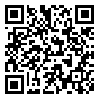1- , ssoury93@gmail.com
Abstract: (307 Views)
High CO2 concentration can negatively affect the concentration and intellectual performance of students and teachers. This study was conducted to assess the air quality of classrooms using the CO2 index in classrooms at the School of Health.
Carbon dioxide concentration was measured using the Aeroqual device at 15, 30, 60 and 90 minutes in 9 classes with three groups of students and on different days, a total of 27 times. The data were analyzed using generalized estimating equations (GEE) technique in Stata 18 software and responses compared with standard values of carbon dioxide concentration using t-tests.
The results show that the air exchange rate varied from 0.01 to 1.39 times per hour, which was far from the standard limit. In most cases, the Co2 concentration exceeded the permissible limit after 15 minutes and continued to increase until the end of the class.
Between 30 and 60 minutes, the concentration trend inside the classrooms was almost constant. And again, the increasing trend continued until the end of the class.
The present study showed that, according to the ASHRAE ventilation standard and the recommendations of the World Health Organization, the ventilation rate in the classrooms was not sufficient. Therefore, it is recommended to improve the air quality of the classrooms by providing mechanical ventilation plans, especially in the cold seasons of the year.
Carbon dioxide concentration was measured using the Aeroqual device at 15, 30, 60 and 90 minutes in 9 classes with three groups of students and on different days, a total of 27 times. The data were analyzed using generalized estimating equations (GEE) technique in Stata 18 software and responses compared with standard values of carbon dioxide concentration using t-tests.
The results show that the air exchange rate varied from 0.01 to 1.39 times per hour, which was far from the standard limit. In most cases, the Co2 concentration exceeded the permissible limit after 15 minutes and continued to increase until the end of the class.
Between 30 and 60 minutes, the concentration trend inside the classrooms was almost constant. And again, the increasing trend continued until the end of the class.
The present study showed that, according to the ASHRAE ventilation standard and the recommendations of the World Health Organization, the ventilation rate in the classrooms was not sufficient. Therefore, it is recommended to improve the air quality of the classrooms by providing mechanical ventilation plans, especially in the cold seasons of the year.
Article number: 6
Keywords: Indoor air quality, carbon dioxide concentration, natural ventilation, educational classroom
Type of Study: Research Article |
Subject:
Chemical agents
Send email to the article author
| Rights and permissions | |
 |
This work is licensed under a Creative Commons Attribution-NonCommercial 4.0 International License. |





